

| Project 1 |  |
Building the hull frames |
Spring of '99 came around and we were finally ready to start preparations for building our boat. In May the weather began to co-operate, so we put in a 50' concrete pad with holes every 3' to mount pipes in for our make-shift tarp shed. We also built a small steel shed to put all the 'big' tools in. In June we built the tent out of triple sections of 10' fence pipe and pulled over a tarp. It is now 36' long. Then we built a gantry out of old drill stem, which proved to be very difficult to cut before we had the plasma cutter, in the shape of two A-frames with a 6" bar connecting the two. Of course the tent would have to be removed to use it as it is 16' high by 16' wide. Instead of using a couple of old railroad tracks, we decided to use heavy rubber wheels to move it back and forth. In early July we purchased the plasma cutter, which I must say, is an amazing piece of equipment. It can slice through 1/4" plate at almost and inch a second! Much easier than conventional means. We have yet to purchase a large Mig welder but our small one will do for tacking pieces together. |
 The
steel arrived last week and we are ready to draw on the patterns from the
blue-prints so I consider this day 1. In the photo is our first plate drawn out.
The
steel arrived last week and we are ready to draw on the patterns from the
blue-prints so I consider this day 1. In the photo is our first plate drawn out.
Day 1:
8 hours. Moved plate into position, cut up and taped plans, then traced onto
first two 5'x10' plates. This is for the webbing. The weather became rainy and
the air humid. Blue-prints don't like humidity so there were several times we
couldn't do anything but wait.
Cut up 12 pieces of webbing using the plasma cutter, Genas home-made travel car, and my freehand abilities. (lucky me!!) |
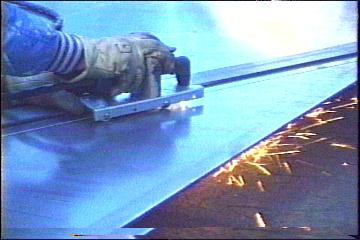 |
 |
The first 2 webbing halves cut! After 9 hours (less lunch) we finished the first 12 pieces That makes 6 webs (frames) |
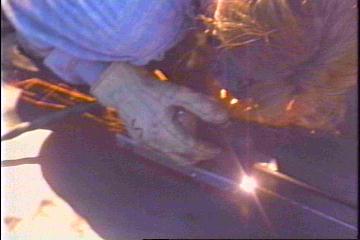
Cut ten more pieces for webbing from sheets 3 & 4. Free-handed curved sections close for minimum grinding time. Only 8 hours including copying blueprints to steel, we're getting better! (Shown at right: paper cut-outs on a proportional paper, 1x2) |
 |
 |
22 cut pieces ready for grinding.
The stack is only 6" high but weighs over 1500 lbs!
The biggest problem we had working with this plate was the fact that it was not cut square! So there was a lot of trimming involved, which used up a lot of time. As amateur carpenters, we only assumed they would be square. ( ASSUME=ASS out of U and ME! ) In the future, we'll make it a point. |
We're no experts when it comes to plasma cutting,
but here's a few things we learned using one:
-Always brace you arms) for stability. It's amazing how quickly it cuts
errors!
-Don't use a plasma cutter to 'trim' thin sheaves of steel off edge, unless
you like replacing tips after every cut!
-If you need to cut a straight edge, do like we did. Make a little cart
to mount the gun on, with wheels. You can see it in some of the
photos. It remains at a constant height, and along a straight flat bar, perfect!
-Work up to a constant speed just below where it can't penetrate fast enough
to cut right through. (Use a practice piece of plate for this! ) This way the
steel can't blob up and it makes for a very clean cut, and less grinding.
-Free handing, even with the cart, is difficult. You have to look at the beam
and near it to see where you're going. I used a #5 shade and don't recommend it.
The marked line is easier to see but I had to move my eyes around constantly to
prevent a nasty case of 'flash' later on! ( Flash is a 'sand in your eye'
feeling that
welders frequently get, that lasts for hours. Not pleasant!) Try #6 or #7
filters first.
-If you have no hand-eye co-ordination at all, I would recommend building a
motorized jig to attach to the cart via a piece of greased 'ready-rod', with a
variable
speed control.( Look in hobby shops) All you would have to do is hold the
trigger
for the cutter down with one hand and the motor control with the other. We're
thinking about doing this for cutting the large hull plating.
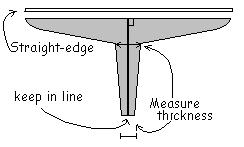
| Day 4 was actually several days during
the week spent during slow times at work grinding and comparing sizes. It
has became apparent that accurate cuts are very important as grinding is
very time consuming and labor intensive! Also setting out the blue prints in only dry weather conditions is a must. We noticed that laying the warm plans on a cool plywood table made a difference, probably due to a bit of moisture present on the plywood. Firstly we lay the cut piece over the plans and plastic to check the lines. Then we grind off any extra on the curved sections. Test the piece at the sole line for straightness, and finally grind down the center side to make even while measuring thickness at known points.(ie tip of keel and top of keel) |
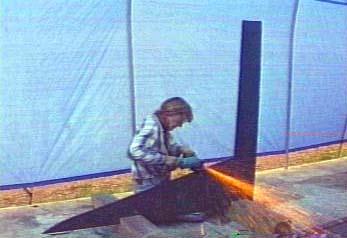 |
Put in the earplugs and ground webs all day long! Started to rain in the late afternoon and blueprints started to grow in size so had to stop. Also arranged plating numerically to put some order to chaos! |
 |
|
||||
 |
|
||||
|
 |
||||

|
|
||||
Completed and plumbed frames 8, 9, & 10.
Finished half of frame 7. They are all pretty light so lifted them by hand.
Will likely find it necessary to lift frames 5, 6 & 7 with the hoist. (
Finally we may get to use it this year! ) Next weekend we plan on actually
erecting some of the frames! Luckily the weather is holding out. |
||||||||||
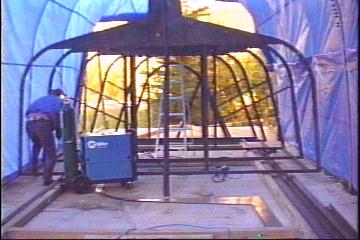
|
Making some measurements off of the plans can be useful for checking heights and widths in the assembled frames to assure accuracy. We're going to do that for the next frames to take away some paranoia! Frame 7 left to complete, hopefully during the week in the evening sometime. Then the rest can be put up at leisure. We couldn't ask for better weather !! ;o)) |
||||||||
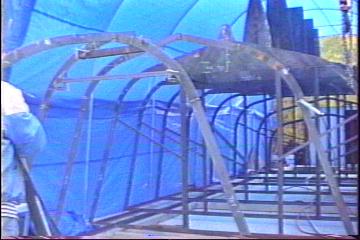 |
|
||||||||
|
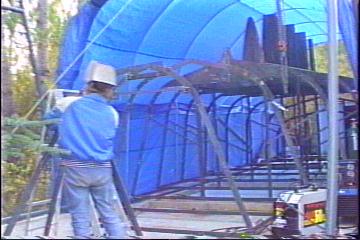 Frames 0, 1 & 2 up and fitting stem (part of stem) in place
|
||||||||
|
|||||||
 |
|
||||||